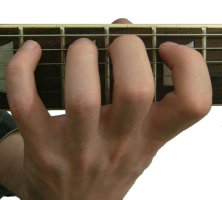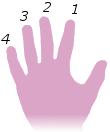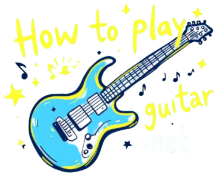Fretting Hand Position
Reminder: As I mentioned on the guitar positioning page, the fretting hand is your left hand (unless you're playing a left-handed guitar; in that case, it will be your right hand).
The thumb is placed behind the neck and normally does not participate directly in playing. The fingers press the strings against the frets.


Keep the fingers in a roundish shape, as if you were holding a lemon. The tips of the fingers are used to press the strings.

Do not bend the finger, like in this picture:

The exception can be if you need to play a couple of nearby strings at the same fret; in this case, you can lay the pad of the finger across those strings to press them down. This method of fretting is called 'little barre', and it is more commonly used with some guitar chords.
The fingers on the fretting hand are identified as follows:
- The index is the 1st finger.
- The middle is the 2nd finger.
- The ring is the 3rd finger.
- The pinky is the 4th finger.

Note that in guitar anatomy, the word "fret" refers to a metal strip located across the fingerboard. However, when talking about guitar playing, the same word "fret" more often means the space between two metal strips, rather than the metal strip itself.
For instance, when you look at some guitar tab and see a note at the third fret, it actually means you need to press the string between the second and the third metal fret to get that note:


It's better to press the string(s) near the metal fret — the one that is closer to the guitar body:

rather than in some random spot between the frets; this way, you'll need to apply less pressure to get a buzz-free sound, and your fingers will navigate more easily around the fingerboard.
Notice and eliminate any unnecessary tension in your hands and arms, which can often occur while you're in the beginning stages. Muscle tension is like rust; it makes playing more clumsy, abrupt and hard.
I've been playing guitar for more than a few years now and the same problem sometimes happens to me as well, especially when I need to play something fast but forget to warm up by practicing in a slow tempo at the beginning of a session.
Note: Often, in guitar tabs, you will encounter a "0" as a fret number, like these ones:
e|---------0-----| B|---------------| G|---------------| D|-----0---------| A|---0-----------| E|---------------|
The "0" stands for an open string. In order to play a note on an open string, avoid touching this string with your fretting hand and only pick it with your picking hand. In other words, your fretting hand does not participate in playing notes on open strings.
